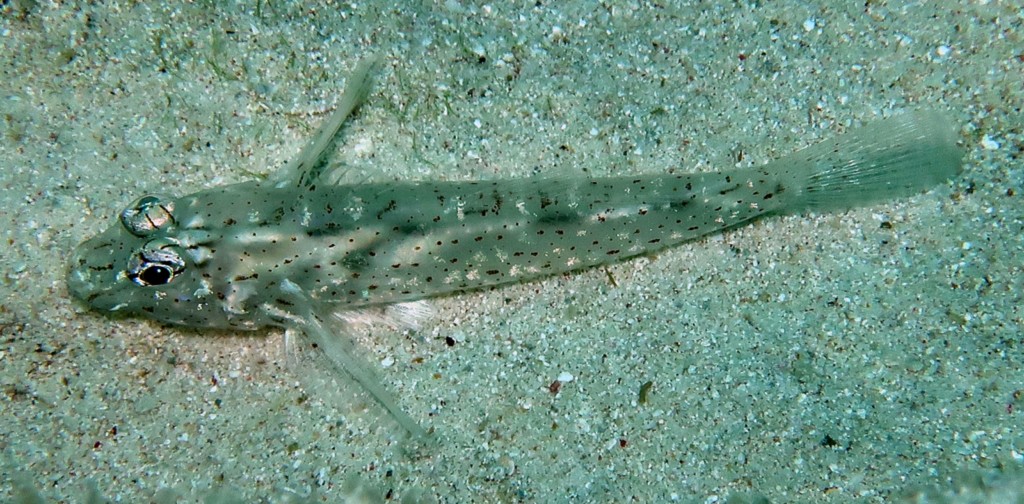FUSIGOBIUS NEOPHYTUS - (GUNTHER, 1877)
Picture courtesy of: Alain Daoulas
Actinopterygii (Gigaclass) > Actinopteri (Class) > Teleostei (Subclass) > Gobiiformes (Order) > Gobioidei (Suborder) > Gobiidae (Family) > Gobiinae (Subfamily) > Fusigobius (Genus)
Gobie des sables nouveau, African fusegoby, Common fusegoby, Fine-spotted sand-goby, Neophyte goby, Neophyte sandgoby, Novice sandgoby, Sand goby, Afrikaanse smeltdikkop, Sankakuhaze, サンカクハゼ, 新鯕塘鱧,
Synonymes
Coryphopterus neophytus (Günther, 1877)
Eviota woolacottae (Whitley, 1958)
Fusigobius africanus (Smith, 1959)
Fusigobius neophyta (Günther, 1877)
Fusigobius neophytus africanis (Smith, 1959)
Fusigobius neophytus africanus (Smith, 1959)
Gobius neophytus (Günther, 1877)
Thalassogobius corallinus (Herre, 1953)
--------------------------
Description
Dorsal spines (total): 7; Dorsal soft rays (total): 9; Anal spines: 1; Anal soft rays: 8; Pectoral fin rays: 16-19 (usually: 17-18); Lateral line scale: 24-25; Longitudinal scale series: 22-24; Depth of body: 4.0-4.6 in SL. Body moderately elongate, compressed posteriorly. Head slightly compressed; Snout pointed; Lower jaw slightly projecting beyond upper jaw; Gill opening not extending anteriorly to a vertical through posterior margin of preopercle; Tongue rounded or near truncate. No elongate, filamentous spine on first dorsal fin; Pelvic fins united medially; Frenum present and well developed. Scales on body ctenoid, exclusive of side of nape, breast and pectoral-fin base with cycloid scales; Median predorsal scales absent, 5-6 scales on side of nape anterior to dorsal fin origin. Head naked. Sensory canals and pores present on head; Reduced longitudinal pattern of sensory papillae on cheek; A pair of sensory papillae just behind chin. Rounded caudal fin. Max. length: 4.0 cm SL. Depth range: 0 - 25 m.
Color
First black spot between first and second dorsal spines; Body with small dark spots and semi-translucent grey with small brown spots on head and body; Presence of slanting bands along back.
Etymology
Fusigobius: from Latin, fusus = spindle + from Latin, gobius = gudgeon.
neophytus: from Latin prefix, neo- = new + from Ancient Greek, phutón = plant, newly planted.
Original description: Gobius neophytus Günther, 1877 - Type locality: Ponape, Micronesia, western Pacific; Apia, Upolu Island, Samoa; Huahine and Tahiti, Society Islands, French Polynesia, South Pacific.
Distribution
Red Sea, Indo-West Pacific: East Africa and Réunion (Mascarenes) east to Wake Atoll and Gambier Islands, north to Ryukyu and Ogasawara islands and southern Japan, south to New Caledonia, Lord Howe Island, Tonga and Rapa.
Biology
Solitary or in small groups. Inhabits tidal reef flats and shallow lagoons, on sand or rubble patches. Feeds on organic matter and small benthic invertebrates. Benthic spawner.
Gobie des sables nouveau, African fusegoby, Common fusegoby, Fine-spotted sand-goby, Neophyte goby, Neophyte sandgoby, Novice sandgoby, Sand goby, Afrikaanse smeltdikkop, Sankakuhaze, サンカクハゼ, 新鯕塘鱧,
Synonymes
Coryphopterus neophytus (Günther, 1877)
Eviota woolacottae (Whitley, 1958)
Fusigobius africanus (Smith, 1959)
Fusigobius neophyta (Günther, 1877)
Fusigobius neophytus africanis (Smith, 1959)
Fusigobius neophytus africanus (Smith, 1959)
Gobius neophytus (Günther, 1877)
Thalassogobius corallinus (Herre, 1953)
--------------------------
Description
Dorsal spines (total): 7; Dorsal soft rays (total): 9; Anal spines: 1; Anal soft rays: 8; Pectoral fin rays: 16-19 (usually: 17-18); Lateral line scale: 24-25; Longitudinal scale series: 22-24; Depth of body: 4.0-4.6 in SL. Body moderately elongate, compressed posteriorly. Head slightly compressed; Snout pointed; Lower jaw slightly projecting beyond upper jaw; Gill opening not extending anteriorly to a vertical through posterior margin of preopercle; Tongue rounded or near truncate. No elongate, filamentous spine on first dorsal fin; Pelvic fins united medially; Frenum present and well developed. Scales on body ctenoid, exclusive of side of nape, breast and pectoral-fin base with cycloid scales; Median predorsal scales absent, 5-6 scales on side of nape anterior to dorsal fin origin. Head naked. Sensory canals and pores present on head; Reduced longitudinal pattern of sensory papillae on cheek; A pair of sensory papillae just behind chin. Rounded caudal fin. Max. length: 4.0 cm SL. Depth range: 0 - 25 m.
Color
First black spot between first and second dorsal spines; Body with small dark spots and semi-translucent grey with small brown spots on head and body; Presence of slanting bands along back.
Etymology
Fusigobius: from Latin, fusus = spindle + from Latin, gobius = gudgeon.
neophytus: from Latin prefix, neo- = new + from Ancient Greek, phutón = plant, newly planted.
Original description: Gobius neophytus Günther, 1877 - Type locality: Ponape, Micronesia, western Pacific; Apia, Upolu Island, Samoa; Huahine and Tahiti, Society Islands, French Polynesia, South Pacific.
Distribution
Red Sea, Indo-West Pacific: East Africa and Réunion (Mascarenes) east to Wake Atoll and Gambier Islands, north to Ryukyu and Ogasawara islands and southern Japan, south to New Caledonia, Lord Howe Island, Tonga and Rapa.
Biology
Solitary or in small groups. Inhabits tidal reef flats and shallow lagoons, on sand or rubble patches. Feeds on organic matter and small benthic invertebrates. Benthic spawner.
